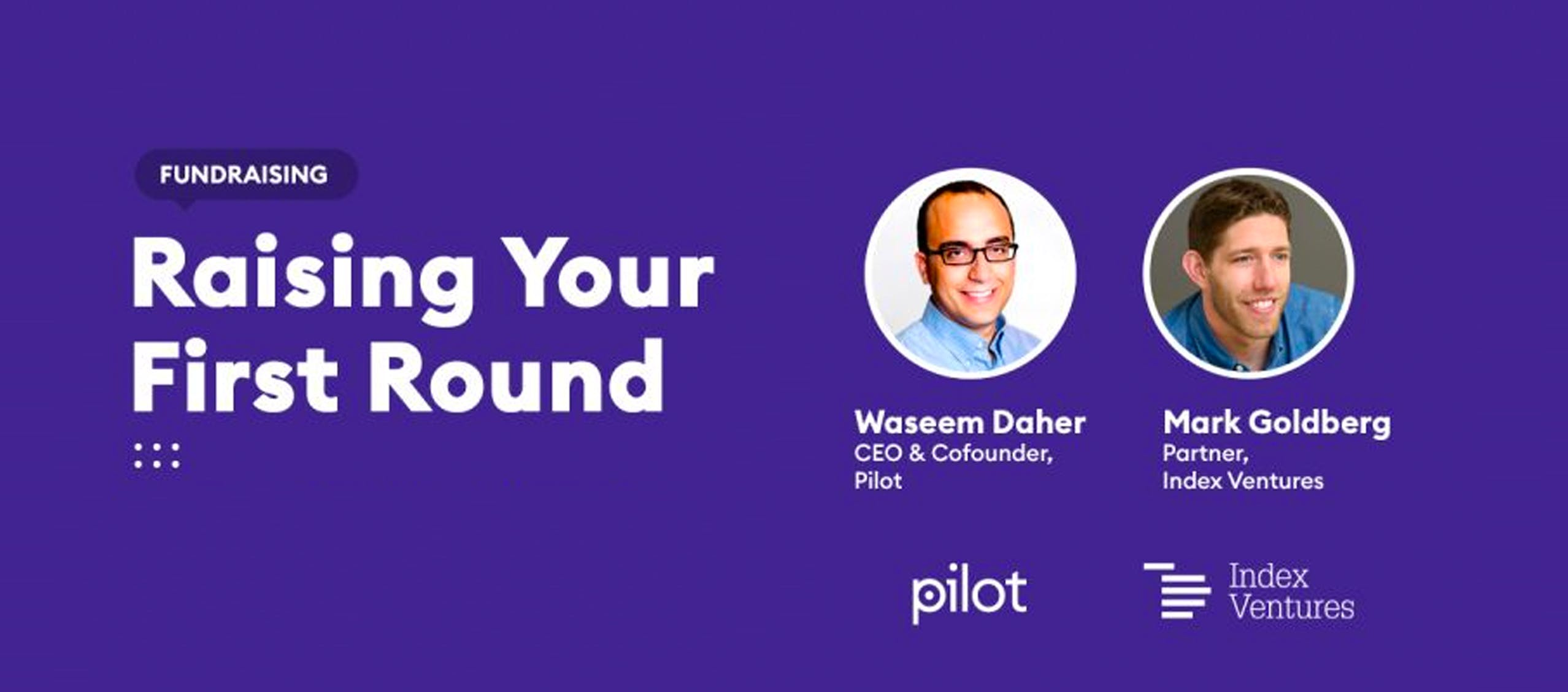Watch: Raising Your First Round
A confirmation email has been sent to your email.

Fundraising, particularly the first fundraise, can be one of the most stressful challenges for a startup founder. Knowing what to expect, and what investors are looking for, can make a big difference as you prepare for a funding round.
Index Ventures partner Mark Goldberg and Pilot CEO/three-time founder Waseem Daher recently sat down to talk about their own experiences with fundraising on both sides of the table, and what founders should know before they raise their first round.
Read an excerpt from the discussion below, or watch the full 36-minute session here.
Fundraising Advice for Raising a First Institutional Round
Mark Goldberg
You’re a great person to talk to about fundraising advice because you’ve been through it a handful of times. Why don’t we just start with generally what you’ve learned from your different experiences over the last decade, and maybe some advice for anyone raising their first round of institutional capital?
Waseem Daher
I think one of the things that’s really interesting, and I know we’re going to touch on this a bit, is just making sure that you’re putting together the right pitch for the right stage that your company is at. Meaning, in the very earliest stages of the company, there is no real traction, there are no real metrics. So what is the question investors are asking?
I’m curious to hear if you agree here, Mark, but for me it’s like, well, what is the opportunity we’re targeting? Why is it super large? Why now? And why is this the team to build it? You’re really telling the story of why the future is going to look like the way you think the future’s going to look like, and why you’re the team to do it. I’m curious if that’s how you evaluate on pre-seed or seed, how you think about that.
Mark Goldberg
I think that’s exactly the narrative [that] I think works really well in a fundraising meeting. Maybe the only thing I’d add to that is, so much of what we’re looking for on the venture side is not on the slide deck. I’m not sure if this will resonate with people on the call, but I think a lot about founder market fit and people that are solving a problem that they’re deeply passionate about, which, again, is hard to convey on a PowerPoint page or on a Notion doc, but is really so much of the early stage criteria we’re looking for. To me, I would say, and Waseem, I’m curious for your perspective on this, I’ve never seen a startup that’s been easy. Even the most successful ones go through super challenging times. So a lot of what we’re testing for in that founder market fit is resiliency.
When this business inevitably gets difficult, is this a team that is going to buckle down and say, “We’re going to power through and find an answer?” Or is it a team that’s going to walk away and go to a different idea? So a lot of what we’re looking for is that enthusiasm, that personal connection with the problem you’re solving. That’s really important to us, and maybe not necessarily something that you can convey in a deck, but you can convey through your storytelling, your narrative, and your personal connection with the business. I think that’s really important.
Determining Round Size for Your Startup
Mark Goldberg
Waseem, can you talk a little bit about when you were fundraising, how you thought about guiding people towards the round sizes, the round dynamics, creating pressure on an investor to not sit on a decision for too long, but also not putting so much pressure an investor you loved, that was a timeline they would never be able to meet? Any tips for folks who might be trying to get the eight to ten first conversations down to an actual term sheet?
Waseem Daher
Yeah. Well, this is super hard. And I want to answer one question that’s adjacent to your question, on top of your question specifically. On round size, here’s how I think you should be thinking about it. Again, there’s a bad way to do this and there’s the right way to do this. I think the bad way to do this is, oh, I’m optimized for valuation and I want that number to be big.
Look, there are marketing benefits for doing that, but I think what people sometimes don’t deeply internalize is, the amount of money you’re raising right now, you have to be thinking about the subsequent round. Meaning, if I’m raising a seed round right now, how much money do I need in the seed round? Well, I need to fast forward my business to the Series A, and I need to ask, what will the metrics need to be for me to raise a successful Series A? And how long is that going to take me? What resources is that going to require?
Like, oh, I want to raise a Series A, I’m making these numbers up, I need a million dollars of ARR. And to get there, I need to hire seven engineers and two sales reps. And it’s going to take me about a year. So that’s going to require X amount of cash. I’ll multiply that by 1.5, so I have a comfortable cushion. That’s how I’d want to construct what the round size is. And then actually, that solves for valuation. It’s like, okay, your investor is going to want to take some ownership stake that’s probably fairly standard, and I need this much cash. You put those numbers into a formula, and that solves for valuation.
How New Founders Can Connect with VCs
Waseem Daher
How do you think about, there’s an initial team, they’ve raised a little bit and self-funded a bit, whether it’s from friends and family or what … And they’re looking at that first seed round? I want to be very direct about how I think about this. For us, we had a deep and extensive network. I mean, I already knew you, we had done two companies prior to this. We were fairly known to top tier investors, we had good connections. What’s your advice for the first time founder who maybe doesn’t have that network? What is the best way to get in front of the right VCs?
Mark Goldberg
I think social media is a really strong avenue at this point, whether it’s Twitter or whether it’s LinkedIn. The amount of exciting pitches we’re hearing that are coming through the non-network channels has increased dramatically. Let’s say that you don’t have those personal connections and it’s impossible for you to find a friend of a friend who can … Maybe it’s a founder that can introduce you to the VCs they work with, which is the best avenue. If it’s open to you, you should take it. But let’s say that it’s not. I would say establish yourself as an expert in the category that you’re building the company in, is another route that is going to draw a lot of attention.
So if you’re on Twitter with 20,000 followers talking about FinTech, you are going to be on people’s radar, in the FinTech investing community. If it’s SaaS, if it’s consumer, infrastructure, the same thing. So I think find a platform that gives you a voice. And if you can’t go through the network route, which is one option, I think that path is also extremely viable at this point. And this is something I would recommend for people that might feel like they’re hitting their head against the wall.
Waseem Daher
Interesting. Interesting. And yeah, definitely, I think that’s newly enabled by, I don’t know, the fact that everyone’s remote, the fact that these platforms are really growing.
Mark Goldberg
The other thing I would consider is, if you’re looking to bridge the gap to the initial set of VCs, some of the incubators can be a strong option. The places where they can serve as a vetting stamp that helps open the doors to VCs. It comes with a significant cost. YC, Y Combinator is not cheap. It’s also bigger and bigger batches, which in some ways, dilutes to investors, the quality bar that people perceive. But for someone that’s coming net new to the community, or wants to really leap frog from where they are to quickly getting on the radar of a lot of investors, an incubator can be a really good path as well.
Pilot gives startups the insights they need to succeed through webinars & digital events with experts, CFOs, founders, and more. To stay in the loop, sign up for notifications or learn more about our finance stack for startups.


